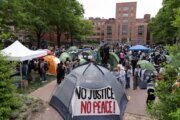YOUKYUNG LEE
AP Business Writer
SEOUL, South Korea (AP) — For the developers of the world’s sixth tallest building near Seoul, a mysteriously shrinking lake and the appearance of small sinkholes in residential neighborhoods couldn’t have come at a more inopportune time.
Plans for the super-high tower first surfaced in 1995 and it took another 15 years to get a green light after the Air Force objected to it as a risk to a nearby military airport used for VIP flights.
Now it faces new doubts as South Korea reels from the Sewol ferry sinking in April that killed hundreds of teenagers. The disaster provoked a scathing reassessment of an ethos of economic progress first, safety last that was largely unquestioned over several decades as the country rapidly industrialized.
In June and July, residents in Songpa neighborhoods surrounding the development reported the appearance of holes on at least two roads, which quickly spread on social media. One about 500 meters from the construction site measured half a meter wide and 20 centimeters deep. There were claims that construction was the cause of falling water levels in the lake the tower overlooks, from a depth of 5 meters to 4.3 meters.
With about 70 of its 123 floors completed, the Lotte World Tower is now undergoing a review by experts and has put on hold the opening of adjacent low-rise buildings that form part of its complex.
“There were expectations that it could be a landmark and attract tourists to the Songpa district and create jobs,” said Lim Hoo-sang, member of a civic group in Songpa. “But after the Sewol accident, people think safety is a sensitive issue.”
Lee Won-woo, CEO of Lotte Moolsan, the tower’s builder, told reporters earlier this month that Lotte has pumped water into the lake to maintain the water level while a separate inspection by Korean and British experts is underway.
Another official at Lotte said the holes are far from the construction site and could be caused by other factors. Songpa district’s local government said the tower is not to be blamed for the sinkholes. But the Seoul city government said it will look at the lake’s lower level and how that affects the land in the area.
Earlier this month, the city took the unusual step of forming an advisory team of lawyers, engineers, architects, environmentalists and university professors to submit their opinions about the construction site. Last week, Seoul denied Lotte approval to open a low-rise shopping mall that is part of the development and said the company needs to resolve traffic problems and improve safety at the construction site as well as disaster prevention plans.
Lotte Group, a conglomerate with businesses spanning retail, hotels, food and chemicals, plans to fill the $3.5 billion complex including the Korean Peninsula’s tallest tower with a high-class hotel, office space, apartments and an observatory.
The safety concerns gained impetus after the ferry sinking in the spring. A probe by prosecutors and state auditors blamed the disaster on a culture of rampant safety negligence at the ferry operator that regulators never seriously questioned. To a nation in deep shock, the April 16 disaster, which killed 294 people with 10 still missing, rammed home the costs of South Korea’s development fetish. It also recalled two disasters from the 1990s: the collapse of a department store that killed 500 people and the failure of a bridge.
“After Sewol, the public’s sentiment has taken a turn to stress safety over any other values including economic development,” said Park Chang-kun, a professor of civil engineering at Kwandong University, who is on the Seoul government’s advisory team on the tower and one of the most vigorous speakers about its safety issues.
While touring the Lotte World Tower construction site, Park said he saw underground water pooling in the sixth basement level, and suspected it came from the lake. While it needs more study, he said water circulation underground could have accelerated due to the construction. He warned that could undermine the ground in the area, home to hundreds of apartment buildings.
If completed by its 2016 target, the 555 meter (1,821 feet) Lotte World Tower would be the world’s sixth-tallest structure beating One World Trade Center by just 10 meters. It will also be the highest landmark on the Korean Peninsula, a title currently claimed by the Ryugyong, a pyramid-shaped hotel in North Korea’s capital Pyongyang. Lotte Group has promoted Lotte World Tower as a global landmark that would lure millions of foreign tourists and contributing to South Korea’s wealth.
That does not seem to strike a chord with the public these days.
“Now there are too many tall towers in the world, so it does not seem to have a special meaning,” said Chung Soo-gong, a self-employed 60-year-old resident of Songpa.
Lotte Group’s founder, Shin Kyuk-ho, long dreamed of owning a super tall tower. But a crucial objection to his plans came from the Air Force, which said a very tall building could endanger landings and takeoffs of military flights on its base just 6 kilometers south of the tower.
It was only after former President Lee Myung-bak took office in 2008 that Lotte was allowed to build over 100-story level. During Lee’s term, the Air Force agreed to Lotte’s plan, on condition that the company paid for changing the angle of a runway. Some thought the move compromised the country’s security.
“It has not guaranteed safety psychologically,” said Park, the civil engineering professor. “Ordinary people would feel even more nervous when Lotte keeps saying it is safe architecture engineering wise.”
___
Follow Lee on Twitter: www.twitter.com/YKLeeAP
Copyright 2014 The Associated Press. All rights reserved. This material may not be published, broadcast, rewritten or redistributed.







